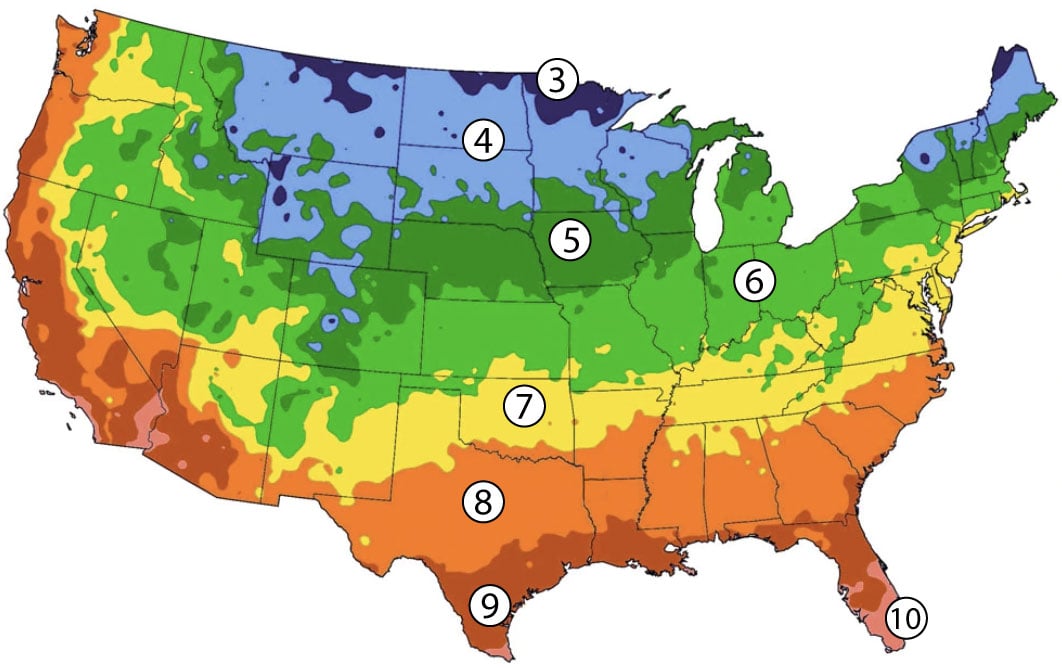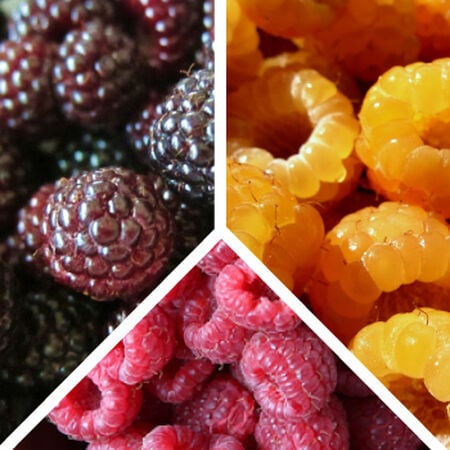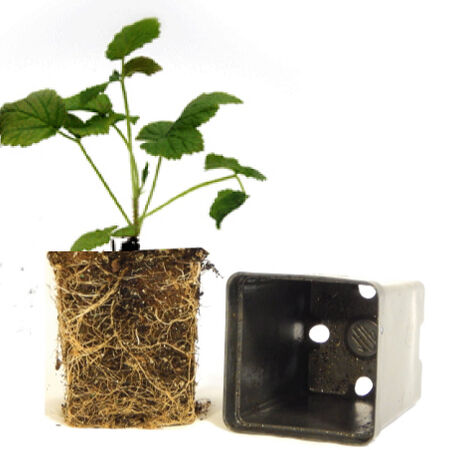Collection Mix, Raspberry Plants
Key Attributes
Product Details
Weight
3Depth
7Height
14Width
7Plant Height
4-5'Botanical Name
Rubus spp.Sow Depth
6-10"Breed
Open-pollinatedSun
Full SunRoot Age
1 Year PlantLife Cycle
PerennialCategories
FruitDays To Maturity (# Days)
365Components
Growing Instructions
![]() Learning Download: How to Grow Raspberries
Learning Download: How to Grow Raspberries
Raspberries grow best in cooler climates, but some newer varieties allow the berries to grow in warmer climates, too. A majority of raspberry plants are summer-fruiting, and they also are self-fertile.
Before Planting: Soak raspberry roots for an hour before planting outside. Prior to planting, amend the soil with some compost.
Planting: When planting, keep the crown of the plant an inch or two above the ground.
Watering: Raspberries require 1-1 1/2 inches of water per week.
Fertilizer: Fertilize raspberry plants in the winter. Use organic fertilizers in the early winter and inorganic fertilizers in late winter or early spring. When using an inorganic fertilizer, opt for a 10-10-10 or a 20-20-20.
Days to Maturity: Raspberries will not produce fruit until their second season of growth. When a raspberry is ripe, it will easily leave the vine so don’t pull too hard or it might become crushed.
Harvesting: To harvest, pick the berries on a sunny day when the fruit is dry. Don’t wash them after picking because the berries will become mushy.
Tips: Make sure you plant the raspberries far away from wild-growing berries, since the wild-growing berries can cause an increase in disease.
Shipping Schedule
Raspberry plants will ship at the appropriate time for your planting zone. The chart below estimates when your raspberry plants will arrive. You will receive an email notifying you when your strawberry roots ship giving you a few days to prepare for planting.
This item’s size, weight, or shape may require an additional shipping surcharge based on the shipping location selected. Specific charges will be displayed during checkout. We are unable to take specific shipping dates at this time.
*This product is perishable and does not ship outside the United States.
|
 |
Our Seed Promise
 "Agriculture and seeds" provide the basis upon which our lives depend. We must protect this foundation as a safe and genetically stable source for future generations. For the benefit of all farmers, gardeners and consumers who want an alternative, we pledge that we do not knowingly buy or sell genetically engineered seeds or plants.
"Agriculture and seeds" provide the basis upon which our lives depend. We must protect this foundation as a safe and genetically stable source for future generations. For the benefit of all farmers, gardeners and consumers who want an alternative, we pledge that we do not knowingly buy or sell genetically engineered seeds or plants.
The mechanical transfer of genetic material outside of natural reproductive methods and between genera, families or kingdoms, poses great biological risks as well as economic, political, and cultural threats. We feel that genetically engineered varieties have been insufficiently tested prior to public release. More research and testing is necessary to further assess the potential risks of genetically engineered seeds. Further, we wish to support agricultural progress that leads to healthier soils, to genetically diverse agricultural ecosystems, and ultimately to healthy people and communities.
To learn more about the "Safe Seed Pledge" please visit www.councilforresponsiblegenetics.org.
Key Attributes
Product Details
Weight
3Depth
7Height
14Width
7Plant Height
4-5'Botanical Name
Rubus spp.Sow Depth
6-10"Breed
Open-pollinatedSun
Full SunRoot Age
1 Year PlantLife Cycle
PerennialCategories
FruitDays To Maturity (# Days)
365Components
Growing Instructions
![]() Learning Download: How to Grow Raspberries
Learning Download: How to Grow Raspberries
Raspberries grow best in cooler climates, but some newer varieties allow the berries to grow in warmer climates, too. A majority of raspberry plants are summer-fruiting, and they also are self-fertile.
Before Planting: Soak raspberry roots for an hour before planting outside. Prior to planting, amend the soil with some compost.
Planting: When planting, keep the crown of the plant an inch or two above the ground.
Watering: Raspberries require 1-1 1/2 inches of water per week.
Fertilizer: Fertilize raspberry plants in the winter. Use organic fertilizers in the early winter and inorganic fertilizers in late winter or early spring. When using an inorganic fertilizer, opt for a 10-10-10 or a 20-20-20.
Days to Maturity: Raspberries will not produce fruit until their second season of growth. When a raspberry is ripe, it will easily leave the vine so don’t pull too hard or it might become crushed.
Harvesting: To harvest, pick the berries on a sunny day when the fruit is dry. Don’t wash them after picking because the berries will become mushy.
Tips: Make sure you plant the raspberries far away from wild-growing berries, since the wild-growing berries can cause an increase in disease.
Shipping Schedule
Raspberry plants will ship at the appropriate time for your planting zone. The chart below estimates when your raspberry plants will arrive. You will receive an email notifying you when your strawberry roots ship giving you a few days to prepare for planting.
This item’s size, weight, or shape may require an additional shipping surcharge based on the shipping location selected. Specific charges will be displayed during checkout. We are unable to take specific shipping dates at this time.
*This product is perishable and does not ship outside the United States.
|
 |
Our Seed Promise
 "Agriculture and seeds" provide the basis upon which our lives depend. We must protect this foundation as a safe and genetically stable source for future generations. For the benefit of all farmers, gardeners and consumers who want an alternative, we pledge that we do not knowingly buy or sell genetically engineered seeds or plants.
"Agriculture and seeds" provide the basis upon which our lives depend. We must protect this foundation as a safe and genetically stable source for future generations. For the benefit of all farmers, gardeners and consumers who want an alternative, we pledge that we do not knowingly buy or sell genetically engineered seeds or plants.
The mechanical transfer of genetic material outside of natural reproductive methods and between genera, families or kingdoms, poses great biological risks as well as economic, political, and cultural threats. We feel that genetically engineered varieties have been insufficiently tested prior to public release. More research and testing is necessary to further assess the potential risks of genetically engineered seeds. Further, we wish to support agricultural progress that leads to healthier soils, to genetically diverse agricultural ecosystems, and ultimately to healthy people and communities.
To learn more about the "Safe Seed Pledge" please visit www.councilforresponsiblegenetics.org.






